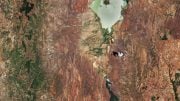
The SpaceX Grasshopper rocket.
SpaceX’s ground-breaking rocket, the Grasshopper, is still in development, but it’s designed to be reusable, meaning that it takes off and lands vertically.
The rocket made its first trip in September 2012, after it traveled 2 meters (6.6 feet) up before landing safely. In November, it went up 32 meters (105 feet) and landed safely. This time, it traveled up 40 meters (131 feet) before landing safely yet again.
The Grasshopper RLV consists of a Falcon 9 Stage 1 tank, a Merlin-1D engine, four steel landing legs, and a steel support structure. Carbon-overwrapped pressure vessels are filled with nitrogen or helium, and attached to the support structure. The Merlin-1D engine has a maximum thrust of 122,000 pounds (54,400 kilograms). It’s 32 meters (105 feet) high, and the tank height is 26 m (85 feet). It uses highly refined kerosene fuel as a propellant and liquid oxygen as the oxidizer.
The Grasshopper would have a reusable first stage for its Falcon 9 rocket, which would be able to land safely instead of falling into the ocean as debris and not being used again. Phase 3 tests will have the goal of increasingly higher altitudes with higher ascent speed and descent speeds. The altitude test sequence would be 366 m (1,200 ft), 762 m (2,500 ft), 1,524 m (5,000 ft), 2,286 m (7,500 ft), and 3,505 m, which is 11,500 feet. The maximum test duration would be about 160 seconds. If all goes according to plan, the Grasshopper would land back on its launch pad.









Be the first to comment on "SpaceX Grasshopper Is First Reusable Rocket"